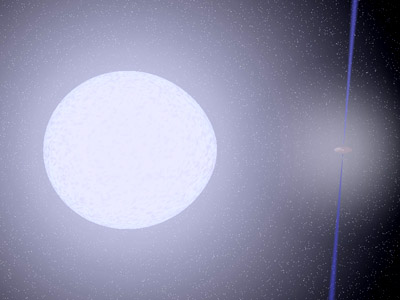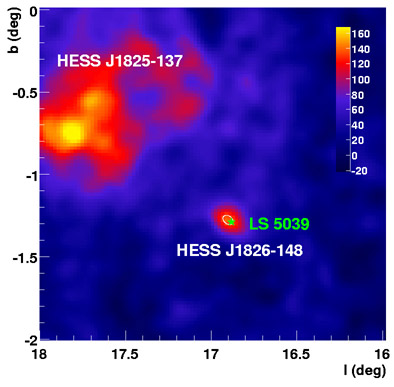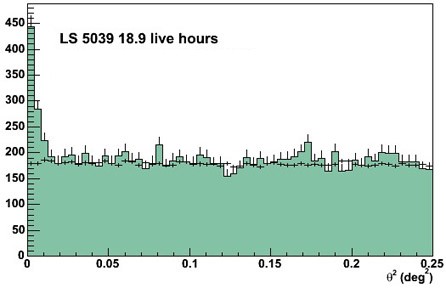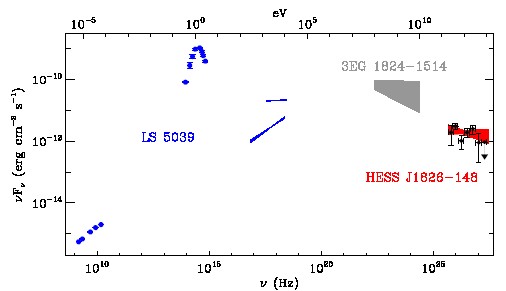Very high energy gamma rays from the microquasar LS 5039
August 2005

"Microquasars" are galactic stellar-mass compact objects - neutrons stars or black holes - which accrete matter. Like in quasars - active galactic nuclei with a supermassive black hole - part of the infalling matter emerges again in form of two relativistic jets, which emit radio waves and X-rays and which might also be able to generate high-energy particles and gamma rays (see e.g. Mirabel & Rodriguez 1999 for a review). The accreted matter is usually provided by a massive star forming a binary system together with the compact object, presumably as a result of a supernova explosion in a double-star system. The study of similarities and differences between microquasars and quasars should shed more light on the processes in these objects.
he binary system LS 5039, at a distance of about 3 kpc, was discovered by Motch et al. 1997, cross-correlating X-ray sources from the ROSAT catalog with OB star catalogues in order to locate systems made of a compact X-ray source orbiting a massive star. Using the VLA radio interferometer, Marti et al. 1998 identified LS 5039 as a nonthermal radio source, supporting the identification. New X-ray observations (Ribo et al. 1999) showed a hard spectrum, but neither pulsed nor periodic emission. Paredes et al. 2000 discovered that the system exhibits radio jets at the milliarcsecond scale; this was confirmed in Paredes et al. 2002. Clark et al. 2001 showed that the mass donor was a O6.5V(f) star. Using radial velocity measurements, McSwain et al. 2001, 2004 succeeded in determining the orbit period to 4.4 days, with an eccentricity of about 0.4. McSwain et al. 2002 suggest, on the basis of the modest X-ray flux, that the compact object accretes matter from the stellar wind of its companion, rather than by direct Roche-lobe overflow. McSwain et al. 004 favors a mass range for the compact object of 1-2 solar masses, a massive companion of 20 to 35 solar masses, and small inclination of the orbit relative to the line of sight. In a recent paper by Casares et al., the orbit period is revised to 3.9 days and based on atmosphere model fitting to the spectrum of the optical companion, a mass of the compact object of about 4 solar masses is estimated, which would point to a black hole rather than a neutron star. LS 5039 is moving with more than 100 km/s perpendicular to the Galactic plane, probably as a result of a recoil generated in the supernova explosion that generated the compact object (Ribo et al. 2002).
he detection of LS 5039 in very high energy gamma rays by H.E.S.S. (Fig. 1, Fig. 2) provides clear evidence that microquasars are indeed capable of accelerating particles to multi-TeV energies. LS 5039 was initially discovered in the H.E.S.S. survey of the central region of the Galactic plane; follow-up observations were conducted to confirm the result. The photon spectrum is rather hard, with a spectral index of ~2.1 (Fig. 3). The detailed mechanisms how the gamma rays are generated are still under discussion. Possible scenarios include inverse-Compton scattering of photons from the companion star, from the accretion disk, or of synchrotron photons (e.g. Bosch-Ramon et al. 2005, Romero et al. 2003 and earlier references given there). However, the flux of photons from the companion star is so large, that gamma rays produced in the vicinity of the compact object are likely to be absorbed, resulting in production of electron-positron pairs (e.g. Bednarek 1997). If nucleons are accelerated, they ought to be able to carry their energy far enough away before interacting and generating gamma rays. A clue could come from an orbital modulation of the gamma-ray flux according to the 4 day orbital period; more data is being collected to probe the time dependence.
References:
Discovery of VHE gamma-ray emission from the X-ray binary LS 5039, H.E.S.S. collaboration, F. Aharonian et al. (Science Express, preprint, H.E.S.S. press release, see also MPG, CNRS, INSU, PPARC)


